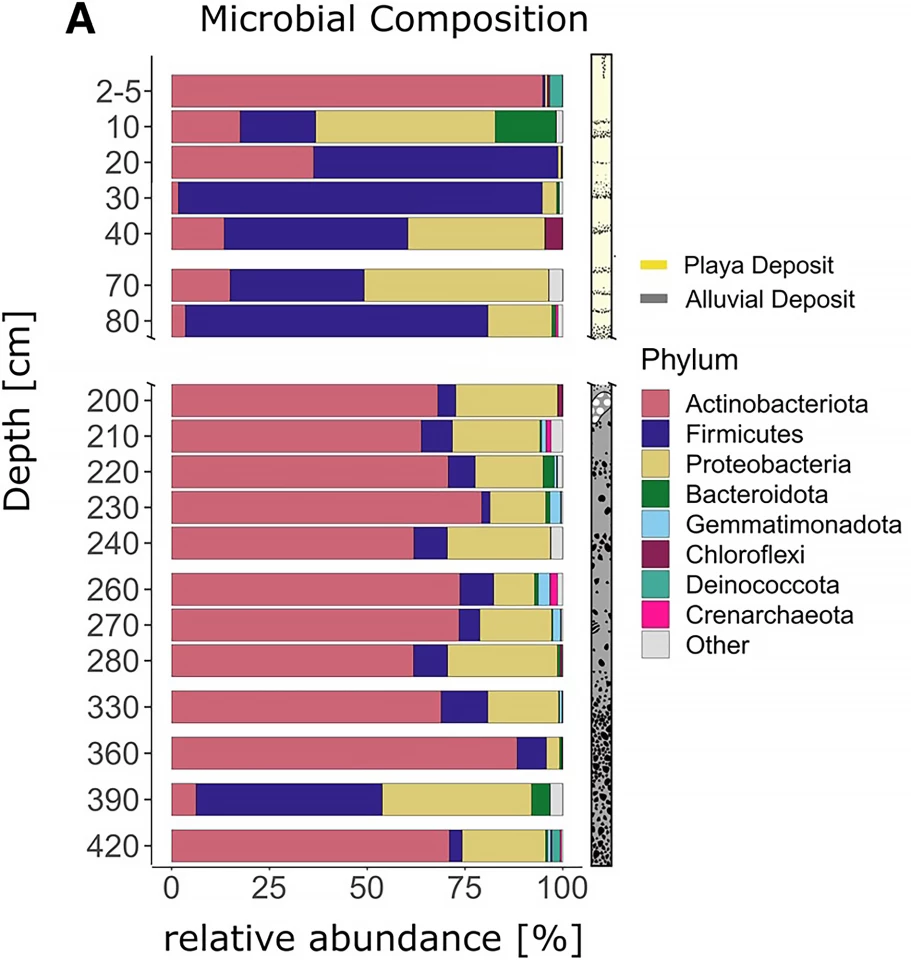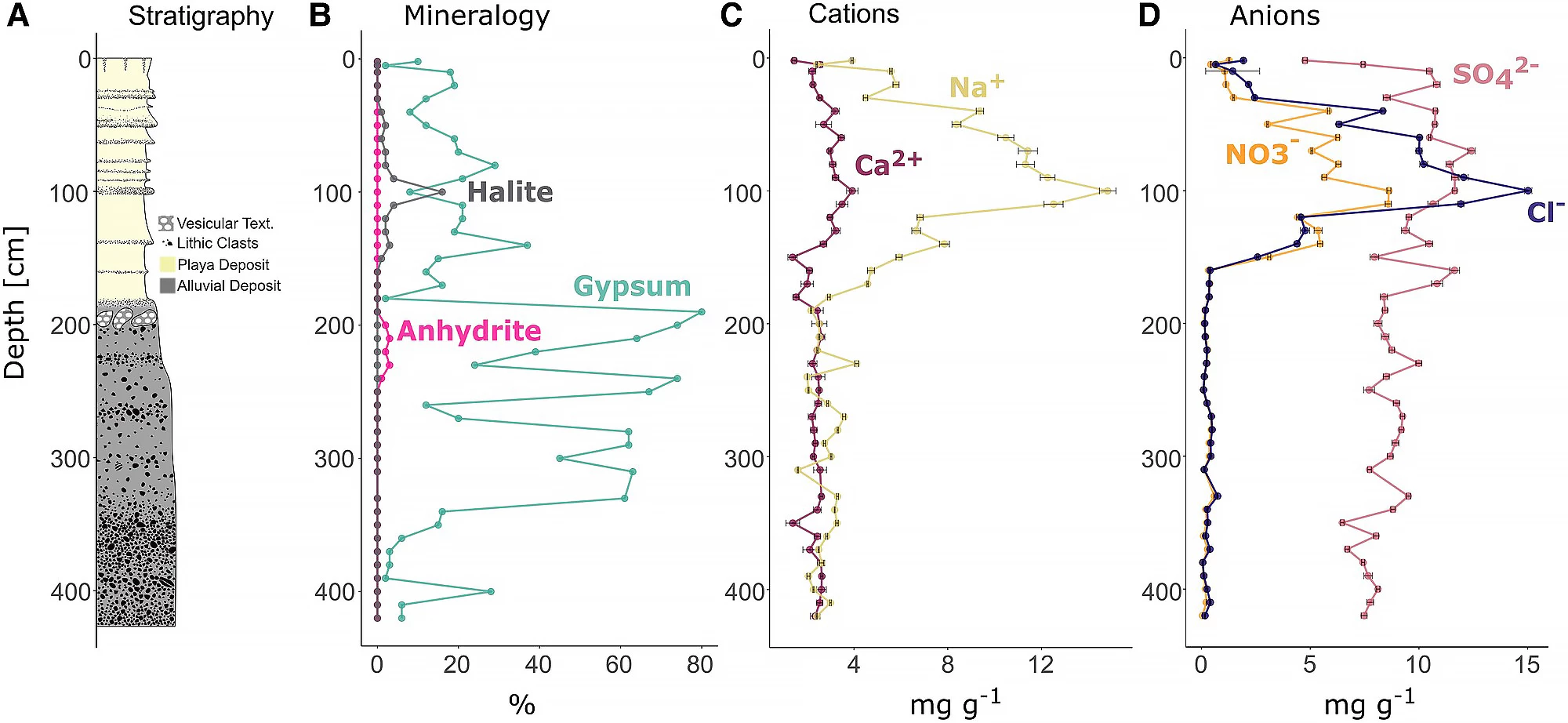As the driest nonpolar desert in the world, the Atacama Desert in northern Chile is home to very few species of plants and animals. With rainfall often occurring only once a decade, the desert is so dry that NASA uses it as a stand-in for the Martian landscape. But what’s living beneath the parched surface? New research suggests it’s very small, abundant, and old, very old.
While the Atacama Desert’s aridity means that higher forms of life are scarce, it’s well-known that diverse bacteria dominate its soils. However, the researchers aimed to go deeper to see what species of microbes lived more than a meter (3.3 ft) beneath the surface.

They selected a site in a playa of the Yungay Valley, one of the driest places of the desert’s hyper-arid core. Playas are depressions or basins that used to contain a surface water body; they’re essentially dry lake beds. In other sites, the minerals gypsum and anhydrite are typically found close to the surface, within the upper 50 cm/20 in, whereas in the playa, they’re buried at a depth of around 2 m/6.6 ft. Gypsum contains water, while anhydrite doesn’t. Instead, anhydrite transforms into gypsum when it’s exposed to water.
As they excavated below the subsurface to a depth of 4.2 m/13.8 ft, the researchers encountered salt accumulations of gypsum, anhydrite and halite, commonly known as rock salt, as well as cations (sodium, calcium) and anions (sulfate, nitrate, chloride).

“The upper half of the profile down to a depth of 184 cm [72.4 in] consisted primarily of silty sediments with intermittent thin sand layers,” said the researchers. “Between 184 and 230 cm [90.6 in] depth, the sediment transitioned to coarser textures, including sand and pebbles. Below 230 cm, the profile was consistently contained of [sic] pebble- to cobble-sized grains.”
They used invertebrate-derived DNA (iDNA) analysis and compared it to geochemical analysis – X-ray diffraction and ion chromatography – to study the microbiology of the subsurface. Gene sequencing revealed an abundance of diverse microbial communities across the different layers.
Most of the sequences were assigned to bacteria; 0.5% were archaea, single-celled microorganisms similar in structure to bacteria but evolutionarily distinct. Archaea are thought to constitute an ancient group between bacteria and eukaryotes or organisms whose DNA-containing cells contain a distinct nucleus. Three bacterial groups (phyla) dominated, accounting for over 90% of genetic sequences: Actinobacteria, Firmicutes, and Proteobacteria.

In the uppermost sediments from 2 to 5 cm (0.8 to 2 in) depth, Actinobacteria represented 95% of microbes. Firmicutes showed a strong presence, ranging from 47% at 40 cm/15.7 in depth to 93% at 30 cm/11.8 in depth. A lower relative abundance of firmicutes (34%) was seen only at 70 cm/27.6 in and decreased significantly below 200 cm/78.7 in. In sediments below 200 cm, microbial communities were again dominated by actinobacteria down to a depth of 4.2 m. Proteobacteria distribution was fairly even across the entire profile.
Ecologically speaking, the playa deposits are relatively young; sedimentation started about 19,000 years ago. However, the alluvial deposits are much older, with depths of 4.2 m dating back up to 3.8 million years. The researchers suggest that the actinobacteria community they discovered might have colonized the soil at the ‘early’ date before being buried under the playa deposits. That might mean a previously unknown deep biosphere continues downwards for an infinite distance under the hyper-arid desert soils.

One of the study's most notable findings was that the microbes were found in sediments below 200 cm depth, where the playa transitions into alluvial deposits composed of gravel, sand, silt, or clay deposited in river channels or on floodplains. It was assumed that microbial diversity and abundance would be less at these depths; it wasn’t. Gypsum has already been shown to support microbial communities in the Atacama Desert. The researchers suggest that, here, the deeper gypsum deposits played a crucial role in microbial diversity by providing water or increasing water retention in the desert’s hyperarid soils.
“Even though gypsum may not be ubiquitous in the subsurface of all deserts, the presence of this subsurface niche could indicate that the global diversity of deserts was underestimated so far and that under given circumstances a subsurface community can persist in the deepest layers of the driest places on Earth,” the researchers said. “[T]his study holds important implications for the search of extremophilic life beyond Earth.”
At the start of the article, it was mentioned that NASA uses the Atacama Desert as a proxy for Mars. Well, Mars also has gypsum deposits. So, could Martian gypsum be a water source for microbial life on that planet, too?
The study was published in the journal PNAS Nexus.
Source: PNAS via EurekAlert!









